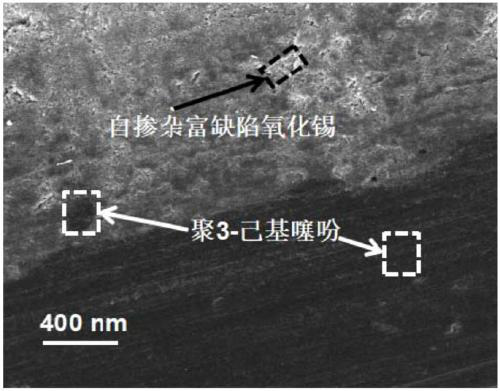Preparation method of poly(3-hexylthiophene)/self-doped defect-riched tin oxide heterojunction nano composite photocatalytic material
A photocatalytic material, a technology of hexylthiophene, is applied in the field of preparation of nanocomposite photocatalytic materials, which can solve the problems of insufficient reaction raw materials, obvious material agglomeration effect and friendliness, etc., and achieves excellent photocatalytic performance, simple process control and good plasticity. Effect
- Summary
- Abstract
- Description
- Claims
- Application Information
AI Technical Summary
Problems solved by technology
Method used
Image
Examples
Embodiment 1
[0027] 1) Get 1mmol analytically pure stannous pyrophosphate (Sn 2 P 2 o 7 ) and 1.5mmol of acetic acid (CH 3 COOH) was fully dissolved in 5 mL of absolute ethanol, and then 0.5 mmol of alkyl dimethyl hydroxypropyl phospholipid betaine, 2 mmol of tea polyphenols and 13 mL of deionized water were added successively, and the whole process was maintained between sodium chloride and In the ice-salt bath of crushed ice, use a constant temperature magnetic stirring device to continuously magnetically stir it at a temperature of -20°C to obtain solution A;
[0028] 2) Transfer solution A to a polytetrafluoroethylene-lined hydrothermal kettle at a filling ratio of 70%, then put the hydrothermal kettle into a constant temperature oven at 100°C for 24 hours, after the hydrothermal reaction is completed, cool to room temperature to obtain Mixed solution B containing self-doped defect-rich tin oxide heterojunction;
[0029] 3) In the ice-salt bath of sodium chloride and crushed ice, u...
Embodiment 2
[0032] 1) Get 1mmol analytically pure stannous pyrophosphate (Sn 2 P 2 o 7 ) and 2.3mmol of acetic acid (CH 3 COOH) was fully dissolved in 12mL of absolute ethanol, and then 3mmol of alkyl dimethyl hydroxypropyl phospholipid betaine, 6mmol of tea polyphenols and 15mL of deionized water were added successively. In the ice-salt bath, use a constant temperature magnetic stirring device to continuously magnetically stir it at a temperature of -15°C to obtain solution A;
[0033] 2) Transfer the solution A to a polytetrafluoroethylene-lined hydrothermal kettle at a filling ratio of 60%, then put the hydrothermal kettle into a constant temperature oven and keep it warm at 140°C for 12h. After the hydrothermal reaction is completed, cool to room temperature to obtain Mixed solution B containing self-doped defect-rich tin oxide heterojunction;
[0034] 3) In the ice-salt bath of sodium chloride and crushed ice, use a constant temperature magnetic stirring device under the conditio...
Embodiment 3
[0038] 1) Get 1mmol analytically pure stannous pyrophosphate (Sn 2 P 2 o 7 ) and 3.6mmol of acetic acid (CH 3 COOH) was fully dissolved in 16mL of absolute ethanol, followed by adding 8mmol of alkyl dimethyl hydroxypropyl phospholipid betaine, 15mmol of tea polyphenols and 23mL of deionized water. In the ice-salt bath, use a constant temperature magnetic stirring device to continuously magnetically stir it at a temperature of -10°C to obtain solution A;
[0039] 2) Transfer solution A to a polytetrafluoroethylene-lined hydrothermal kettle at a filling ratio of 35%, and then put the hydrothermal kettle into a constant temperature oven at 180°C for 1 hour. After the hydrothermal reaction is completed, cool to room temperature to obtain Mixed solution B containing self-doped defect-rich tin oxide heterojunction;
[0040] 3) In the ice-salt bath of sodium chloride and crushed ice, use a constant temperature magnetic stirring device to carry out under the condition of continuou...
PUM
 Login to View More
Login to View More Abstract
Description
Claims
Application Information
 Login to View More
Login to View More - R&D
- Intellectual Property
- Life Sciences
- Materials
- Tech Scout
- Unparalleled Data Quality
- Higher Quality Content
- 60% Fewer Hallucinations
Browse by: Latest US Patents, China's latest patents, Technical Efficacy Thesaurus, Application Domain, Technology Topic, Popular Technical Reports.
© 2025 PatSnap. All rights reserved.Legal|Privacy policy|Modern Slavery Act Transparency Statement|Sitemap|About US| Contact US: help@patsnap.com

